Towards More Accurate Determination of the Thermoelectric Properties of Bi2Se3 Epifilms by Suspension via Nanomachining Techniques
Abstract
1. Introduction
2. Materials and Methods
3. Results
4. Summary
Supplementary Materials
Author Contributions
Funding
Institutional Review Board Statement
Informed Consent Statement
Data Availability Statement
Conflicts of Interest
References
- Rong, G.; Zheng, Y.; Sawan, M. Energy Solutions for Wearable Sensors: A Review. Sensors 2021, 21, 3806. [Google Scholar] [CrossRef] [PubMed]
- Choi, H.-S.; Yun, S.; Whang, K.-i. Development of a temperature-controlled car-seat system utilizing thermoelectric device. Appl. Therm. Eng. 2007, 27, 2841–2849. [Google Scholar] [CrossRef]
- Zoui, M.A.; Bentouba, S.; Stocholm, J.G.; Bourouis, M. A Review on Thermoelectric Generators: Progress and Applications. Energies 2020, 13, 3606. [Google Scholar] [CrossRef]
- Goupil, C.; Seifert, W.; Zabrocki, K.; Müller, E.; Snyder, G.J. Thermodynamics of Thermoelectric Phenomena and Applications. Entropy 2011, 13, 1481–1517. [Google Scholar] [CrossRef]
- Dames, C. Cost optimization of thermoelectric materials for power generation: The case for ZT at (almost) any cost. Scr. Mater. 2016, 111, 16–22. [Google Scholar] [CrossRef]
- DiSalvo, F.J. Thermoelectric cooling and power generation. Science 1999, 285, 703–706. [Google Scholar] [CrossRef] [PubMed]
- Cutler, M.; Leavy, J.F.; Fitzpatrick, R.L. Electronic Transport in Semimetallic Cerium Sulfide. Phys. Rev. 1964, 133, A1143–A1152. [Google Scholar] [CrossRef]
- Snyder, G.J.; Toberer, E.S. Complex thermoelectric materials. Nat. Mater. 2008, 7, 105–114. [Google Scholar] [CrossRef]
- Sootsman, J.R.; Chung, D.Y.; Kanatzidis, M.G. New and old concepts in thermoelectric materials. Angew. Chem. Int. Ed. Engl. 2009, 48, 8616–8639. [Google Scholar] [CrossRef] [PubMed]
- Pei, Y.; LaLonde, A.D.; Heinz, N.A.; Shi, X.; Iwanaga, S.; Wang, H.; Chen, L.; Snyder, G.J. Stabilizing the optimal carrier concentration for high thermoelectric efficiency. Adv. Mater. 2011, 23, 5674–5678. [Google Scholar] [CrossRef] [PubMed]
- Hor, Y.S.; Richardella, A.; Roushan, P.; Xia, Y.; Checkelsky, J.G.; Yazdani, A.; Hasan, M.Z.; Ong, N.P.; Cava, R.J. p-type Bi2Se3 for topological insulator and low-temperature thermoelectric applications. Phys. Rev. B 2009, 79, 195208. [Google Scholar] [CrossRef]
- Chen, Z.-G.; Han, G.; Yang, L.; Cheng, L.; Zou, J. Nanostructured thermoelectric materials: Current research and future challenge. Prog. Nat. Sci. Mater. Int. 2012, 22, 535–549. [Google Scholar] [CrossRef]
- Minnich, A.J.; Dresselhaus, M.S.; Ren, Z.F.; Chen, G. Bulk nanostructured thermoelectric materials: Current research and future prospects. Energy Environ. Sci. 2009, 2, 466–479. [Google Scholar] [CrossRef]
- Szczech, J.R.; Higgins, J.M.; Jin, S. Enhancement of the thermoelectric properties in nanoscale and nanostructured materials. J. Mater. Chem. 2011, 21, 4037–4055. [Google Scholar] [CrossRef]
- Dresselhaus, M.S.; Chen, G.; Tang, M.Y.; Yang, R.G.; Lee, H.; Wang, D.Z.; Ren, Z.F.; Fleurial, J.-P.; Gogna, P. New Directions for Low-Dimensional Thermoelectric Materials. Adv. Mater. 2007, 19, 1043–1053. [Google Scholar] [CrossRef]
- Liu, T.-H.; Zhou, J.; Li, M.; Ding, Z.; Song, Q.; Liao, B.; Fu, L.; Chen, G. Electron mean-free-path filtering in Dirac material for improved thermoelectric performance. Proc. Natl. Acad. Sci. USA 2018, 115, 879–884. [Google Scholar] [CrossRef]
- Beekman, M.; Morelli, D.T.; Nolas, G.S. Better thermoelectrics through glass-like crystals. Nat. Mater. 2015, 14, 1182–1185. [Google Scholar] [CrossRef]
- Chang, C.; Wu, M.; He, D.; Pei, Y.; Wu, C.-F.; Wu, X.; Yu, H.; Zhu, F.; Wang, K.; Chen, Y.; et al. 3D charge and 2D phonon transports leading to high out-of-plane ZT in n-type SnSe crystals. Science 2018, 360, 778–783. [Google Scholar] [CrossRef]
- Yang, L.; Gordon, M.P.; Menon, A.K.; Bruefach, A.; Haas, K.; Scott, M.C.; Prasher, R.S.; Urban, J.J. Decoupling electron and phonon transport in single-nanowire hybrid materials for high-performance thermoelectrics. Sci. Adv. 2021, 7, eabe6000. [Google Scholar] [CrossRef]
- Boukai, A.I.; Bunimovich, Y.; Tahir-Kheli, J.; Yu, J.-K.; Goddard, W.A., III; Heath, J.R. Silicon nanowires as efficient thermoelectric materials. Nature 2008, 451, 168–171. [Google Scholar] [CrossRef] [PubMed]
- Hochbaum, A.I.; Chen, R.; Delgado, R.D.; Liang, W.; Garnett, E.C.; Najarian, M.; Majumdar, A.; Yang, P. Enhanced thermoelectric performance of rough silicon nanowires. Nature 2008, 451, 163–167. [Google Scholar] [CrossRef] [PubMed]
- Harman, T.C.; Taylor, P.J.; Walsh, M.P.; LaForge, B.E. Quantum Dot Superlattice Thermoelectric Materials and Devices. Science 2002, 297, 2229–2232. [Google Scholar] [CrossRef]
- Lin, C.-K.; Chen, M.-S.; Huang, R.-T.; Cheng, Y.-C.; Lee, P.-Y. Thermoelectric Properties of Alumina-Doped Bi0.4Sb1.6Te3 Nanocomposites Prepared through Mechanical Alloying and Vacuum Hot Pressing. Energies 2015, 8, 12573–12583. [Google Scholar] [CrossRef]
- Alam, H.; Ramakrishna, S. A review on the enhancement of figure of merit from bulk to nano-thermoelectric materials. Nano Energy 2013, 2, 190–212. [Google Scholar] [CrossRef]
- Cahill, D.G. Thermal conductivity measurement from 30 to 750 K: The 3ω method. Rev. Sci. Instrum. 1990, 61, 802–808. [Google Scholar] [CrossRef]
- Borca-Tasciuc, T.; Kumar, A.; Chen, G. Data reduction in 3ω method for thin-film thermal conductivity determination. Rev. Sci. Instrum. 2001, 72, 2139–2147. [Google Scholar] [CrossRef]
- Dames, C.; Chen, G. 1ω, 2ω, and 3ω methods for measurements of thermal properties. Rev. Sci. Instrum. 2005, 76, 124902. [Google Scholar] [CrossRef]
- Lu, L.; Yi, W.; Zhang, D. 3ω method for specific heat and thermal conductivity measurements. Rev. Sci. Instrum. 2001, 72, 2996–3003. [Google Scholar] [CrossRef]
- Li, G.; Liang, D.; Qiu, R.L.J.; Gao, X.P.A. Thermal conductivity measurement of individual Bi2Se3 nano-ribbon by self-heating three-ω method. Appl. Phys. Lett. 2013, 102, 043104. [Google Scholar] [CrossRef]
- Hasan, M.Z.; Kane, C.L. Colloquium: Topological insulators. Rev. Mod. Phys. 2010, 82, 3045–3067. [Google Scholar] [CrossRef]
- Brahlek, M.; Lapano, J.; Lee, J.S. Topological materials by molecular beam epitaxy. J. Appl. Phys. 2020, 128, 210902. [Google Scholar] [CrossRef]
- Ginley, T.P.; Wang, Y.; Law, S. Topological Insulator Film Growth by Molecular Beam Epitaxy: A Review. Crystals 2016, 6, 154. [Google Scholar] [CrossRef]
- Richardella, A.; Zhang, D.M.; Lee, J.S.; Koser, A.; Rench, D.W.; Yeats, A.L.; Buckley, B.B.; Awschalom, D.D.; Samarth, N. Coherent heteroepitaxy of Bi2Se3 on GaAs (111)B. Appl. Phys. Lett. 2010, 97, 262104. [Google Scholar] [CrossRef]
- Ohtake, A.; Nakamura, J.; Komura, T.; Hanada, T.; Yao, T.; Kuramochi, H.; Ozeki, M. Surface structures of GaAs{111}A,B-(2×2). Phys. Rev. B 2001, 64, 045318. [Google Scholar] [CrossRef]
- Bansal, N.; Kim, Y.S.; Edrey, E.; Brahlek, M.; Horibe, Y.; Iida, K.; Tanimura, M.; Li, G.-H.; Feng, T.; Lee, H.-D.; et al. Epitaxial growth of topological insulator Bi2Se3 film on Si(111) with atomically sharp interface. Thin Solid Films 2011, 520, 224–229. [Google Scholar] [CrossRef]
- Park, S. Measurement of the Field-Angle-Dependent Spin Nernst Voltage across Ferromagnetic Probes. Ph.D. Thesis, Seoul National University, Seoul, Korea, 2022. [Google Scholar]
- Yang, C.; Lee, J.-H.; Jo, M.; Choi, H.K.; Park, S.; Kim, Y.D.; Cho, S.U.; Kim, D.; Park, Y.D. Nanomachining-enabled strain manipulation of magnetic anisotropy in the free-standing GaMnAs nanostructures. Sci. Rep. 2019, 9, 13633. [Google Scholar] [CrossRef] [PubMed]
- Tang, H.; Wang, X.; Xiong, Y.; Zhao, Y.; Zhang, Y.; Zhang, Y.; Yang, J.; Xu, D. Thermoelectric Characterization of Individual Bismuth Selenide Topological Insulator Nanoribbons. Nanoscale 2015, 7, 6683–6690. [Google Scholar] [CrossRef] [PubMed]
- Guo, M.; Wang, Z.; Xu, Y.; Huang, H.; Zang, Y.; Liu, C.; Duan, W.; Gan, Z.; Zhang, S.-C.; He, K.; et al. Tuning thermoelectricity in a Bi2Se3 topological insulator via varied film thickness. New J. Phys. 2016, 18, 015008. [Google Scholar] [CrossRef]
- Chen, Q.; Chen, J.; Xu, X.; Wang, Z.; Ding, Y.; Xiong, L.; Zhu, B.; Tao, L. Morphology Optimization of Bi2Se3 Thin Films for Enhanced Thermoelectric Performance. Cryst. Growth Des. 2021, 21, 6737–6743. [Google Scholar] [CrossRef]
- Paulatto, L.; Fournier, D.; Marangolo, M.; Eddrief, M.; Atkinson, P.; Calandra, M. Thermal conductivity of Bi2Se3 from bulk to thin films: Theory and experiment. Phys. Rev. B 2020, 101, 205419. [Google Scholar] [CrossRef]
- Wright, D.A. Thermoelectric Properties of Bismuth Telluride and its Alloys. Nature 1958, 181, 834. [Google Scholar] [CrossRef]
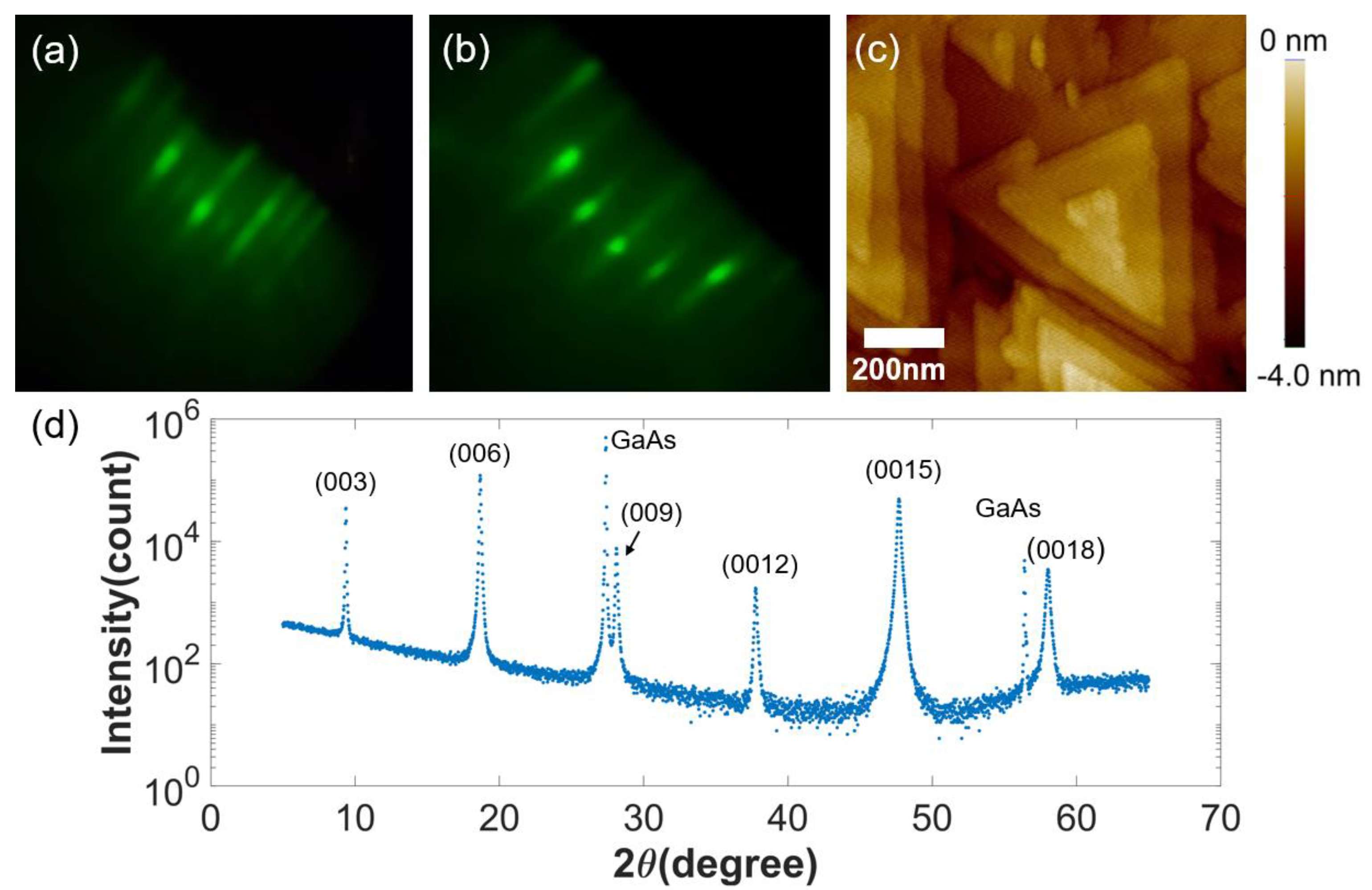
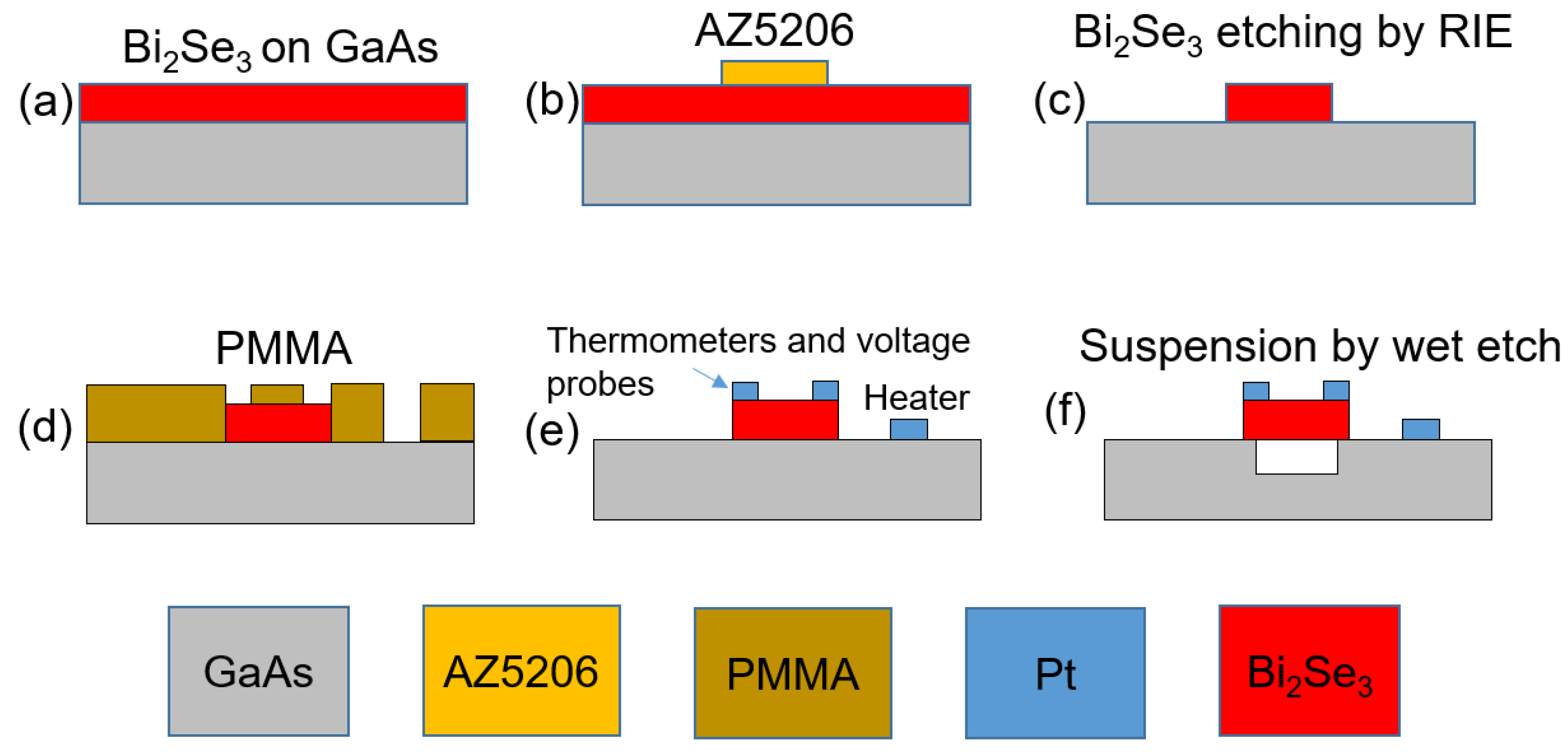
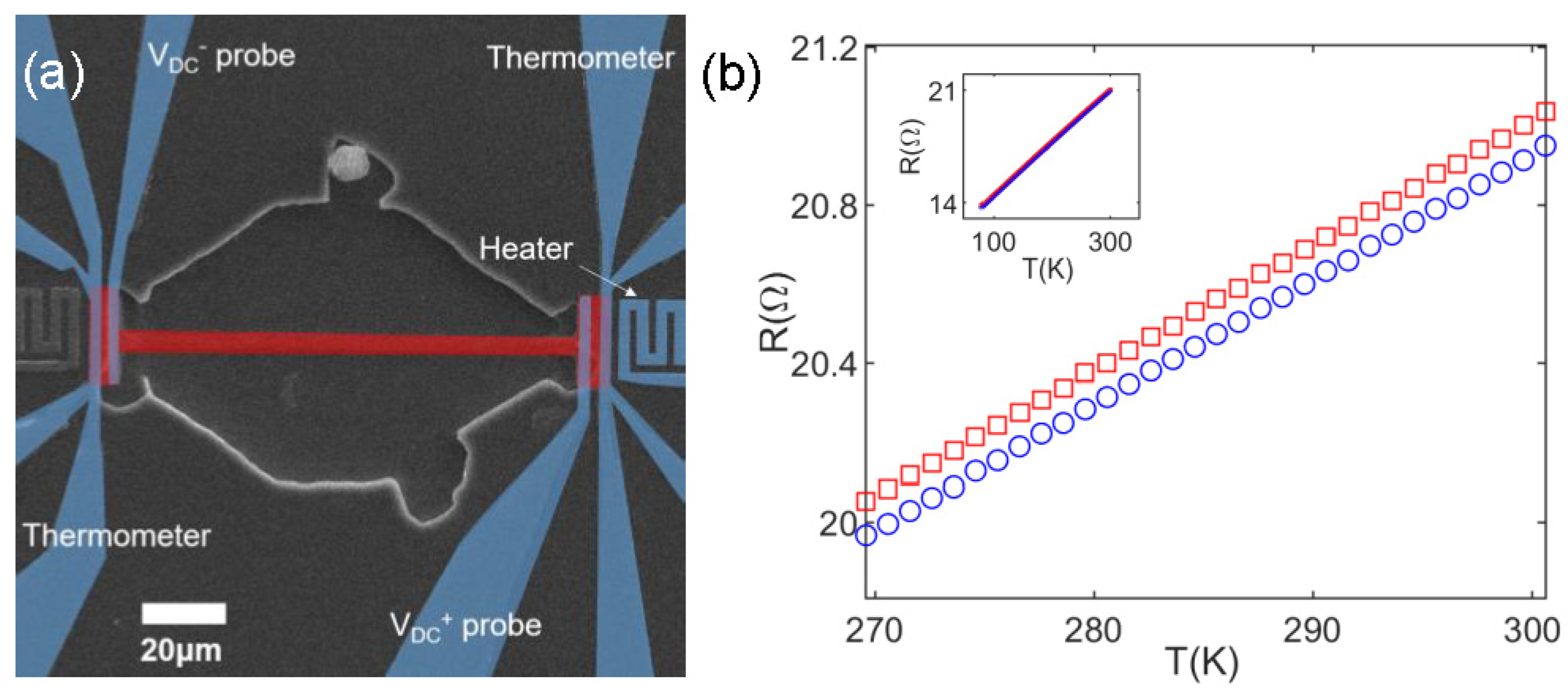

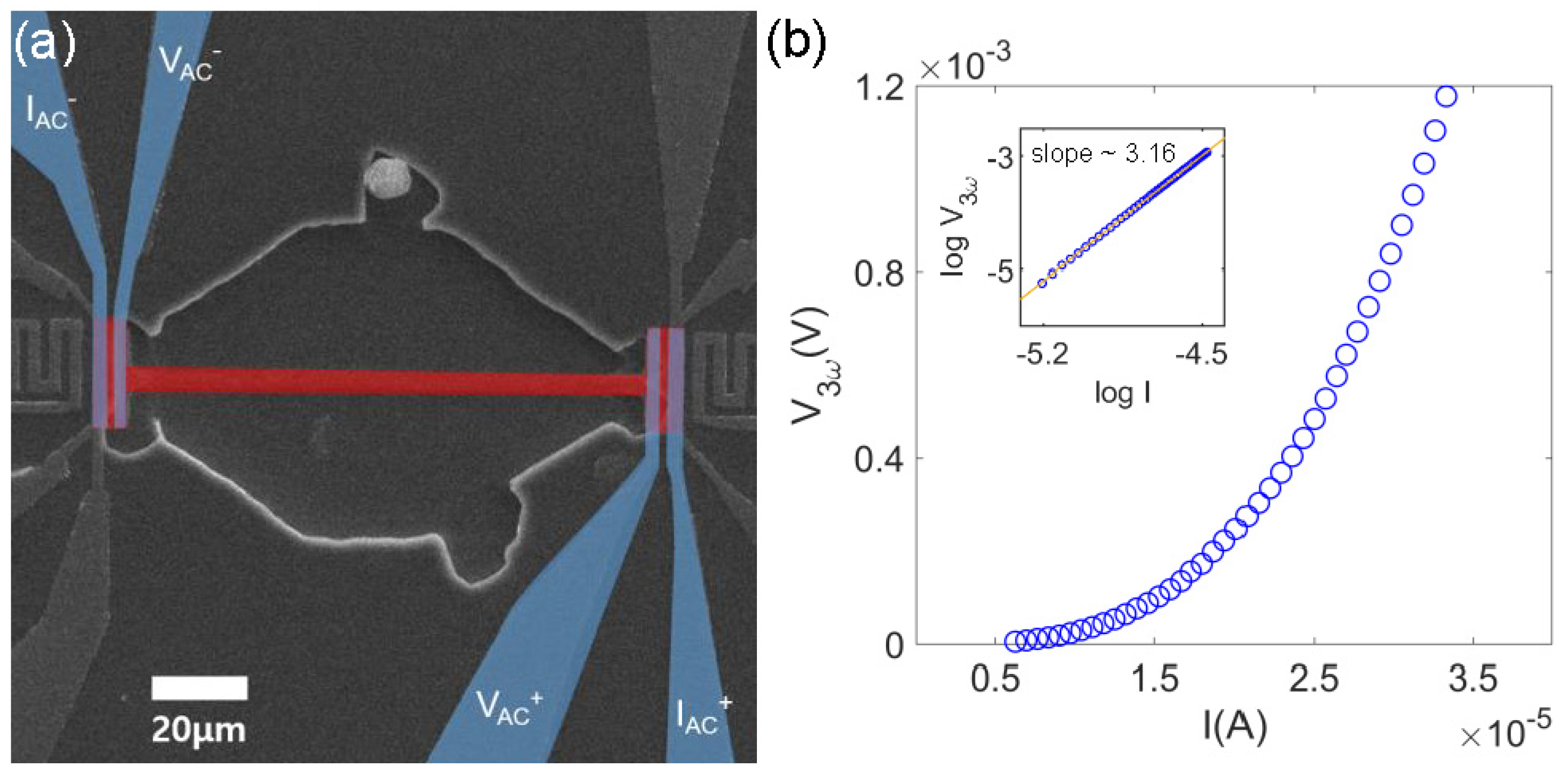
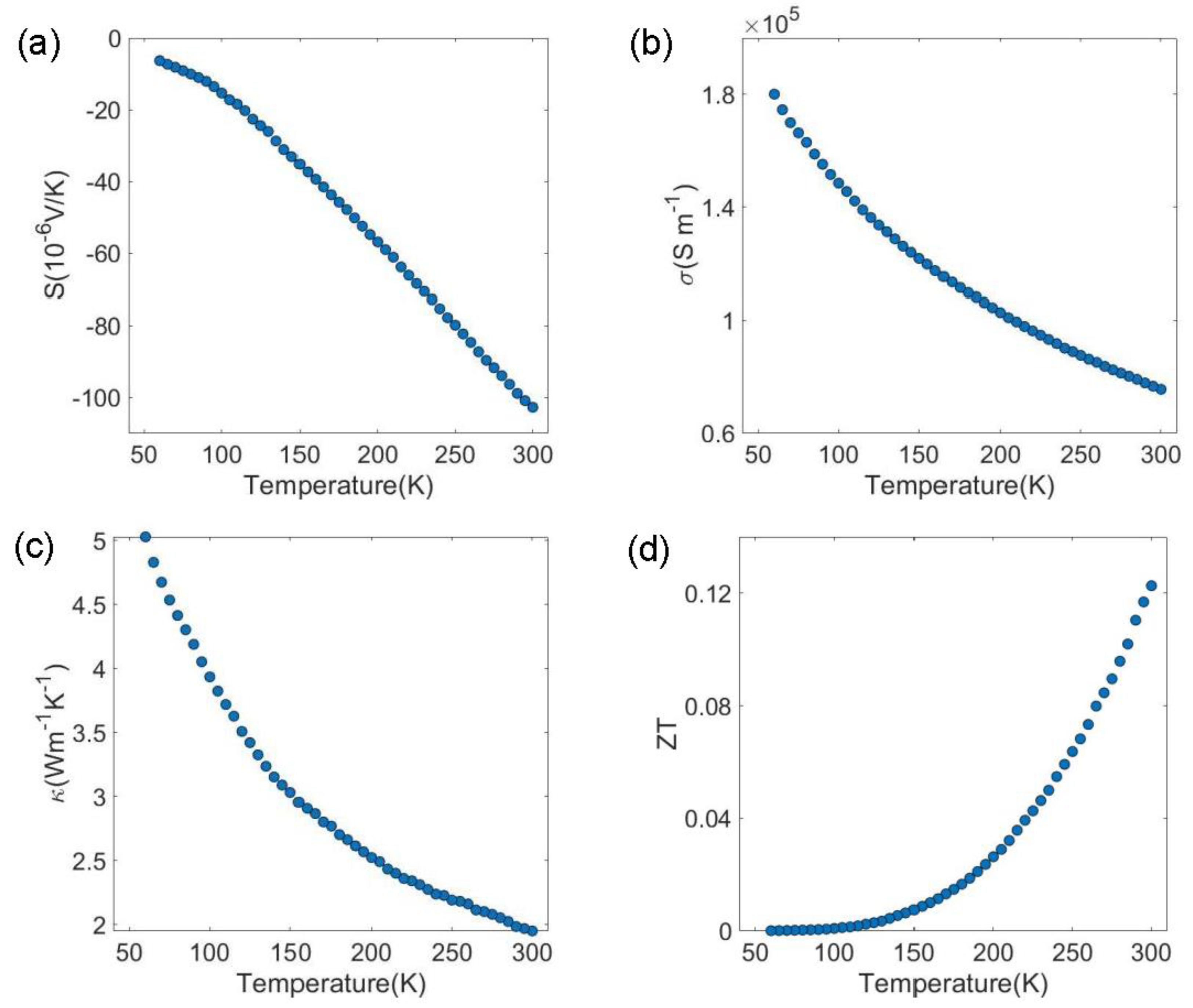
| Type of Bi2Se3 | κ (W/mK) | σ (104 S/m) | S (μV/K) | ZT |
|---|---|---|---|---|
| mechanically exfoliated Bi2Se3 [28] | ~2.1 | N/A | N/A | N/A |
| nanoribbon synthesized via VLS (S2) [38] | ~1.7 | ~7 | −120 | 0.17 |
| 30 nm epifilm [39] | N/A | ~6 | −100 | N/A |
| 77 nm vapor solid grown Bi2Se3 [40] | N/A | 15.9 | −99.9 | N/A |
| 200 nm epifilm (this report) | ~1.9 | ~7.6 | −103 | 0.12 |
| bulk [41] | 4 | 16 | −70 | 0.05 |
Publisher’s Note: MDPI stays neutral with regard to jurisdictional claims in published maps and institutional affiliations. |
© 2022 by the authors. Licensee MDPI, Basel, Switzerland. This article is an open access article distributed under the terms and conditions of the Creative Commons Attribution (CC BY) license (https://creativecommons.org/licenses/by/4.0/).
Share and Cite
Kim, D.; Yang, C.; Park, Y.D. Towards More Accurate Determination of the Thermoelectric Properties of Bi2Se3 Epifilms by Suspension via Nanomachining Techniques. Sensors 2022, 22, 8042. https://doi.org/10.3390/s22208042
Kim D, Yang C, Park YD. Towards More Accurate Determination of the Thermoelectric Properties of Bi2Se3 Epifilms by Suspension via Nanomachining Techniques. Sensors. 2022; 22(20):8042. https://doi.org/10.3390/s22208042
Chicago/Turabian StyleKim, Donguk, Chanuk Yang, and Yun Daniel Park. 2022. "Towards More Accurate Determination of the Thermoelectric Properties of Bi2Se3 Epifilms by Suspension via Nanomachining Techniques" Sensors 22, no. 20: 8042. https://doi.org/10.3390/s22208042
APA StyleKim, D., Yang, C., & Park, Y. D. (2022). Towards More Accurate Determination of the Thermoelectric Properties of Bi2Se3 Epifilms by Suspension via Nanomachining Techniques. Sensors, 22(20), 8042. https://doi.org/10.3390/s22208042







